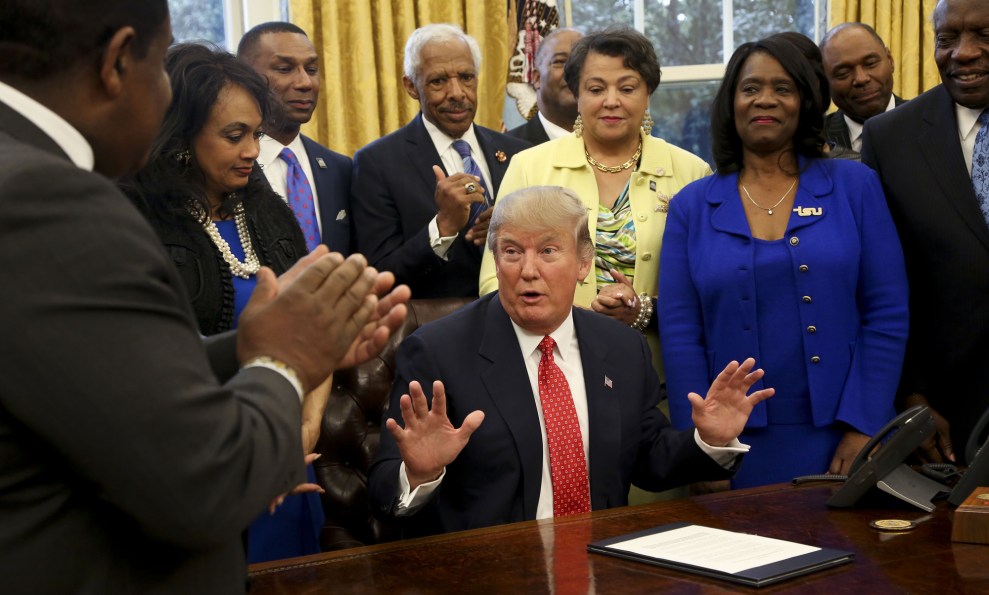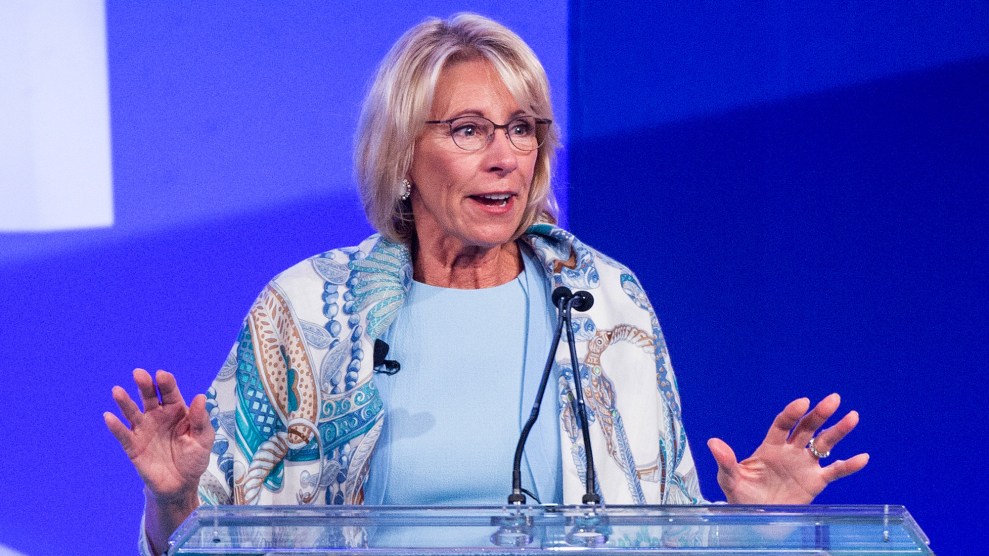
The signing of an executive order in FebruaryAude Guerrucci/ZUMA
On the morning of February 27, more than 70 presidents of historically black colleges and universities (HBCUs) stood in a West Wing corridor, waiting to enter the Oval Office. The meeting with President Donald Trump would be historic—the first time the head of every HBCU in the country had been invited to meet with the president at the White House. Top aides Kellyanne Conway, Stephen Bannon, Stephen Miller, and Reince Preibus mixed and mingled with the group. According to Morgan State University President David Wilson, who was among those attending, Bannon voiced a promise: “If you give us a plan, we will execute it.” The implication was clear, Wilson says: Tell us what resources HBCUs need and the administration will find a way to pay for them in Trump’s budget.
The Oval Office meeting was one of many conversations and phone calls since Election Day between HBCU presidents, leaders of HBCU advocacy groups, and the Trump White House. Earlier that day, the White House had promoted a newspaper story headlined “President Trump Seeks to Outdo Obama in Backing Black Colleges,” which alluded to a plan for “historic” support for the schools. The next day, Trump signed an executive order that relocated a federal office devoted to helping fund and support black colleges from the Department of Education into the White House.
“We will make HBCUs a priority in the White House,” Trump said at the signing. “An absolute priority.”
But for leaders and advocates of these institutions, the release of Trump’s budget in late May did nothing of the sort. Trump not only proposed no new funding for HBCUs, but also called for slashing millions of dollars from federal programs that support degree programs at the schools. Trump’s plan appeared to boost Pell Grants by extending their use to year-round—but meanwhile called for taking away $5 billion-plus in reserves from the Pell program and cutting at least $1.5 billion from other federal financial aid programs, including work study. Taken together, these cuts would disproportionately affect low-income students at black colleges and cost the schools millions in revenue.
“The perception that many HBCU presidents were operating under was that the administration was making a commitment to follow up with a substantial investment in the institutions,” Wilson told me recently. “What we see now certainly does not meet my definition of substantial investment.”
“The budget doesn’t match” earlier messaging from the White House, said Walter Kimbrough, the president of Dillard University. “I’ll be interested to see how members of his team will say this undergirds his recent support for HBCUs. At least for Dillard, I can say it’s a loss.”
Advocates were further perplexed by Trump and questioned his commitment when he suggested in a statement in early May that special funding for black colleges could be unconstitutional. (After his comments drew a backlash, Trump expressed his “unwavering support” for HBCUs again in another statement.)
According to HBCU advocates, the Trump administration’s outreach has been spearheaded by senior communications aide Omarosa Manigault and Ja’Ron Smith, who leads urban renewal efforts on Trump’s domestic policy team. Manigualt and Smith, who are Howard University graduates, did not respond to requests for comment. (Disclosure: I am a Howard graduate.)
Early this year, HBCU advocacy groups jointly proposed a plan for federal funding to the Trump administration. They asked that two key Department of Education programs that support HBCUs be funded at $500 million, the maximum level permitted by Congress, and that the Trump administration commit to increasing for HBCUs the percentage of grants and contracts reserved for institutions of higher education in the federal budget. They argued passionately that HBCUs could play a key role in a Trump plan to create new opportunities for African Americans: The schools have an outsize impact, enrolling 8 percent of all black college students in America and producing approximately 15 percent of those who earn bachelor’s degrees. (The nation’s approximately 100 HBCUs constitute 3 percent of the nation’s colleges and universities.) The schools also graduate large numbers of first-generation college students; roughly 70 percent of the more than 290,000 students enrolled at HBCUs are low-income—more than twice the rate for college students nationally. Howard University is especially known for its many graduates who become lawyers, dentists, doctors, and engineers.
Johnny Taylor, president of the Thurgood Marshall College Fund, says the news about Trump’s budget hasn’t been all bad—HBCUs were mostly insulated from a proposed 13 percent across-the-board cut hitting the Department of Education, which supplies the majority of federal funding to HCBUs. Even being able to retain that core funding under Trump “is something that our community should celebrate,” Taylor says.
But Kimbrough sees that as “moving the goal posts,” especially after a promise was in the air from the White House. He and Wilson told Mother Jones that the other cuts, including those to financial aid programs, could cost their schools six- or possibly even seven-figure sums in revenue and would impact hundreds of their schools’ students. “When you take away any money from any of the students that are on Pell Grants or coming from limited-resource families, you are putting them closer and closer to going back home,” Wilson said. Even with as little as a few hundred dollars per semester—”those dollars actually mean the world for our students.”
For many HBCU families, “it’s a sacrifice to get students to go to school,” Kimbrough said. So even relatively small cuts in federal aid can be devastating for them. Morgan State already spends around 15 percent of its budget on financial aid—a larger percentage than any other college in Maryland, according to Wilson; the school simply can’t afford to subsidize cuts to government aid for more students.
Even after the first Trump budget proposal in March, skepticism was already stirring about the promises from the Trump White House. “This budget proposal is not a new deal for African Americans,” Congressional Black Caucus chairman and Morehouse College alumnus Cedric Richmond said, speaking broadly of Trump’s first budget proposal, which proposed lesser cuts to HBCU funding than the May version. “It’s a raw deal that robs the poor and the middle-class to pay the richest of the rich.”
Though the Oval Office meeting in February generated optimism among HBCU presidents, it was controversial among some students and alumni. A picture of the meeting that showed the presidents posing with Trump while Conway sat with her feet on the couch and her head in her phone was criticized as disrespectful. People who attended the meeting told Mother Jones that Conway was perched on the couch because she had been asked to take a picture of the large group and was then trying to get out of the way of the official White House photographer. But making matters worse, hours after that photo went viral, Secretary of Education Betsy DeVos described HBCUs in a statement as “real pioneers when it comes to school choice.” A torrent of criticism followed from black campuses and their alumni, who wondered whether DeVos understood that most HBCUs were founded because black students were banned from attending whites-only schools in the Jim Crow South. (DeVos later corrected her remarks.)
Students on some HBCU campuses have protested scheduled visits by Trump officials. In May, graduating seniors at Bethune-Cookman University booed and turned their backs to DeVos as she gave her commencement speech. Days later, Texas Southern University canceled a commencement speech by Texas Sen. John Cornyn after students said they did not want to hear from him because he’s a Trump supporter.
A backlash had begun brewing in February: At Howard University, DeVos met with the school’s president as her first official act as secretary of education. The day after the Oval Office meeting with HBCU leaders, Howard students awoke to graffiti spray-painted on the school’s main yard that read “Welcome to the Trump Plantation. Overseer: Wayne A. I. Frederick,” referring to the school’s president. Graffiti left elsewhere said “Wayne Frederick doesn’t care about black people.” (Frederick said he did not attend the Oval Office meeting.) Days later at a commemoration for the 150th anniversary of Howard’s founding, members of a student activist group stood up with signs and a megaphone and called out the president in front of a packed auditorium.
“Does this [potential] increase in funding buy the allegiance of HBCU presidents to Donald Trump? That is what I think is a great concern for students organizing on campus,” Allyson Carpenter, the student body president, told me back in March.
Trump “threatens to send the feds into Chicago, and we all know what that means as black people,” Yvonne Hamel, a freshman and a member of the group, told me. “He openly speaks about [banning] Muslims. We have a large population of students that come from foreign countries. So we want to make sure that this [Howard] administration is not compromising” the interests of its students in exchange for funding, she said.
Howard is one of two colleges nationwide that receives an appropriation as a line item in the federal budget each year. (The other is Galludet University.) In a meeting with the student activist group in March, Frederick said the university’s unique relationship with the federal government required that he keep an open relationship with the White House. He said he made a case for increasing Howard’s appropriation in every meeting he’d had with a Trump official. Hamel said her group’s members appreciated that argument but wanted assurance that Frederick would challenge the Trump administration on policies that could hurt Howard students. An email that Frederick sent to students and faculty the day after the presidential election—in which he congratulated Trump on his win but did not comment on the bigoted rhetoric that marked Trump’s campaign—was not a good sign, Hamel said.
Fredrick did, however, rally on behalf of Howard students in the face of Trump policies: He hired a private attorney to handle the cases of two students who were prevented for several days from entering the country after Trump’s travel ban took effect in January. He also stressed in the meeting with student activists that the administration does not provide information about students’ immigration status or whereabouts to the federal government unless required by a court order.
At Howard’s commencement this May, Sen. Kamala Harris—herself a Howard graduate—urged students to speak out against injustice in the Trump era. Carpenter said she saw Trump’s failure to increase funding for HBCUs as proof that February’s White House meeting was just for show. “We all knew what this was,” she said. “Everyone expected this.”
Trump’s budget is subject to approval by Congress, which is where HBCU advocates say they will now focus their efforts. In February, they made their case to GOP lawmakers including House Speaker Paul Ryan, Sen. Marco Rubio, and Rep. Trey Gowdy during a meeting spearheaded by South Carolina Rep. Tim Scott. Wilson told me he’s hopeful there will be a bipartisan effort in Congress to restore some of Trump’s proposed cuts. He said he plans to spend more time with his school’s congressional representatives on Capitol Hill in the months ahead.
HBCUs need to make sure that Congress fully grasps “the kind of impact that our institutions are having at the local, state, and national level,” he says. “I think when you look at the value proposition of HBCUs to this nation, it seems to me that it’s a very easy opportunity for investment.”







